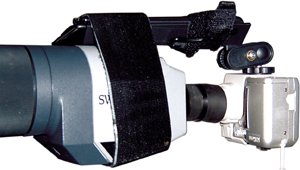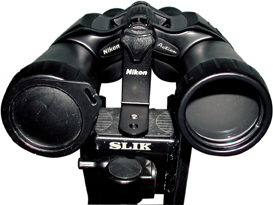Hack 94 Get Close with Digiscoping
| < Day Day Up > |
Hack 94 Get Close with Digiscoping Chances are, you already have the tools to get close to your subjects, even if they have little beaks and are perched way across the yard . Wildlife photos taken with consumer-level digital cameras are often disappointing. To get a better shot, you must inch forward slowly, hoping to get close to the animal, or have powerful optics that make it seem like you're closer than you really are. Since most birds won't tolerate you standing next to them while they peck at their dinner, most enthusiasts find themselves longing for telephoto camera lenses they can't afford. To address this situation without maxing out the credit card, birders have turned to innovation. The most common hack is known as digiscoping . In its simplest form, digiscoping simply means using a spotting scope to zoom in on the subject and then holding the camera to the eyepiece to record the image. Many consumer digital cameras have lens diameters that are similar in size to the lenses on birding scopes (or any other optical device), so they are a natural fit. Digiscoping can be used to get impressive, high-quality wildlife photos, to help prove and document what you've seen, or simply to give you a fun way to share and record your informal observations.
Surprisingly good results can sometimes be achieved by simply holding the camera up to the scope's eyepiece. This method is useful mainly when you have plenty of light (which gives you fast shutter speeds) and need to act fast. In lower-light situations, where shutter speeds are slower, your slight movements while holding the camera are magnified by the scope, which results in a soft picture. A variety of commercial brackets that allow you to focus the scope and then move the camera into place quickly are now coming to market, but they are pricey. Many people have had stunningly good success with homemade rigs. For example, I attached my Nikon Coolpix to a scope with some industrial-grade Velcro and a Pedco Ultrapod II [Hack #1] , as shown in Figure 8-22. I used a Nikon auxiliary lens adapter to fit the camera lens inside the rubber cup on the spotting scope's eyepiece. This setup isn't the height of elegance , but the pictures I captured pleasantly surprised me. I've also learned that if your camera doesn't have a lens-adapter attachment, you can cut the bottom out of a plastic film canister and rig that up instead. Figure 8-22. A digiscoping rig This is not to say that I got perfect results with the first exposure. I learned many little tips and tricks that have really improved the percentage of successful pictures:
In my birding community, the most popular digiscoping digicams have been the Nikon Coolpix 950/990/995/4500 series (http://www.nikon.com). Their internal zoom optics make it easier to get close to the scope's eyepiece without actually touching, and the swivel joint allows easy adjustment of the LCD viewer of the camera. The most popular scope seems to be the Swarovski AT HD 80mm (http://www.eagleoptics.com/Swarovski/Spotting+Scopes/pid3453). However, don't be discouraged if you have something else; experimenting is half the fun, especially if you can do it without going broke. Read on! 8.10.1 Digiscoping on the CheapDon't despair if you don't already have a scope; you can still get some of the benefits of digiscoping at a fraction of the cost by using a good pair of binoculars or a monocular. To digibinox , you'll need to attach your binoculars to a tripod. I was able to get an inexpensive (US$10) binocular bracket mount that lets me use my Nikon Action binoculars with any standard threaded tripod head, as shown in Figure 8-23. Many binoculars have a threaded socket; sometimes, it's hidden beneath a removable button in the front, where the two halves meet. Once you get your binoculars mounted, you might want to keep the lens cap over one lens and work on getting exact focus on the side you'll use for the camera. Figure 8-23. Binoculars mounted to a tripod It also helps if you can fully extend your binocular's eyecups and use them to get a snug and stable fit against one binocular lens. You can try various tubelike adapters to achieve a nice fit. The Nikon Coolpix 775 is a low-end camera, but I've found that the optional UR-E3 converter/adapter (normally used for attaching accessory lenses) is quite useful for fitting the camera lens into the eyecup of binoculars or a scope, and it keeps out ambient light. Since binoculars have a lower magnification than scopes, camera shake isn't as much of a problem, and your results when hand-holding the camera can be quite satisfying . They won't give you the super-close views of a scope with a professional camera-attachment system, but you might be pleasantly surprised by what you can achieve at a fraction of the price. Figure 8-24 shows a comparison of the results you can achieve with your normal zoom lens, binoculars, and a spotting scope. For all three shots, I used a Nikon Coolpix 775 two-megapixel digital camera that was positioned 22 feet away from the subject. The top image was captured with its built-in 3x optical zoom. The middle shot was also taken with the 3x optical zoom, but the lens was hand-held to the eyepiece of a pair of Nikon Action 7 50 binoculars. The bottom image also used the 3x optical zoom, but this time it was hand-held to a Swarovski ST-80 scope with a 22x eyepiece. Figure 8-24. Images captured with zoom lens, binoculars, and spotting scope Also experiment with monoculars, if you have them. Some varieties even have threaded screws that can be used to attach them elegantly to cameras.
8.10.2 See Also
Terrie Miller |
| < Day Day Up > |
EAN: 2147483647
Pages: 161

